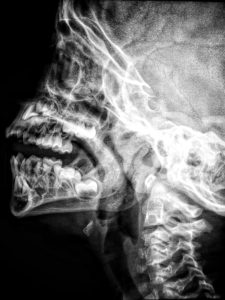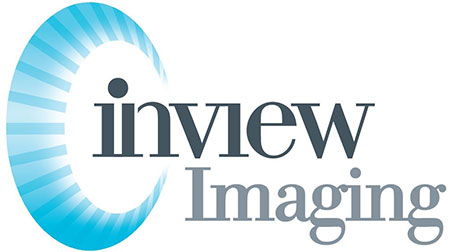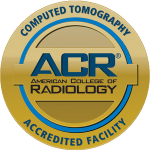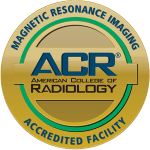InView Imaging: Safe, comfortable, accessible CT
CT, or Computed Tomography, is a non-invasive imaging procedure used to diagnose and monitor a variety of conditions. It provides detailed cross-sectional images of the body’s internal structures, making it essential for detecting issues in the brain, chest, abdomen, and bones. CT scans are invaluable for evaluating conditions like tumors, fractures, internal bleeding, and infections.
At InView Imaging, we prioritize your safety by minimizing radiation exposure through best practices and state-of-the-art technology. Our team of experienced radiologists employs advanced techniques to ensure the lowest possible radiation dose while maintaining high-quality images. We are committed to providing the safest and most effective diagnostic services.
Our team of compassionate and experienced radiologists and staff is here to provide personalized care tailored to your specific needs. From the moment you arrive, you will be greeted by our friendly staff, ready to guide you through every step and answer any questions you may have.InView Imaging proudly serves the community with CT facilities in Antioch, Oakland, and Fremont. We accept most insurance plans, making our services accessible and stress-free. Trust us to provide exceptional radiology services with a personal touch.
The CT scan, a radiology imaging technique, stands out as a powerful diagnostic tool. By combining X-rays with advanced computer technology, CT scans, an imaging technique in radiology, provide detailed cross-sectional images of the body. Unlike traditional X-rays, CT scanning in radiology offers a more comprehensive view with contrast material, allowing healthcare professionals to detect and diagnose conditions in medicine with greater precision.
CT scans, a radiology scanning technique, are invaluable in identifying internal injuries, tumors, and abnormalities in organs such as the brain, lungs, and abdomen. This non-invasive procedure plays a crucial role in guiding treatment plans and monitoring disease progression. With its ability to capture clear and detailed images swiftly using scanning technique, the CT scan has revolutionized modern medicine by enabling swift and accurate diagnoses.
Understanding CT Scans
Basic Principles
CT scans, also known as computed tomography scans, use X-rays in scanning to create detailed cross-sectional images of the body. These X-ray beams rotate around the patient, capturing multiple angles that are processed by a computer to generate comprehensive images. The process helps healthcare providers visualize internal structures with precision and clarity. CT scans play a crucial role in diagnosing a wide range of medical conditions due to their ability to provide detailed insights into organs, tissues, and bones.
Key Uses
CT scans are invaluable tools for scanning and diagnosing various health issues such as tumors, fractures, infections, and internal bleeding. They excel in scanning and detecting abnormalities, including cancer, in different parts of the body such as the brain, chest, abdomen, and pelvis. By producing high-quality images quickly and efficiently, CT scans enable physicians to identify conditions early on and devise appropriate treatment strategies promptly. Moreover, these scans aid in monitoring the effectiveness of ongoing treatments and surgical interventions.
Procedure Overview
Before undergoing a CT scan procedure, patients may need to abstain from eating or drinking for a few hours if contrast dye is required for enhanced imaging results. Upon arrival at the imaging facility or hospital department, individuals will be asked to change into a gown and remove any metal objects that could interfere with the scan. During the actual scan process, patients lie down on a motorized table that moves through a doughnut-shaped machine called a CT scanner. While inside the CT scanner, they need to remain still as it emits X-ray beams to capture detailed images from different angles.
Why CT Scans are Performed
Diagnostic Benefits
CT scans provide highly accurate and efficient diagnostic results. These imaging tests, including ct scanning, offer detailed images that aid in precise diagnosis. By capturing cross-sectional views of the body, CT scans help detect both structural and functional abnormalities accurately.
Monitoring Conditions
CT scans are crucial for monitoring disease progression over time. They play a vital role in tracking how well treatments are working. CT scans assist healthcare providers in managing diseases effectively and providing necessary follow-up care.
Pre-surgical Planning
CT scans play a significant role in planning surgical procedures meticulously. These scans allow surgeons to visualize internal structures with great clarity before surgery. By ensuring precise visualization, CT scans contribute to successful surgical interventions.
Preparing for a CT Scan
Contrast Material Guidelines
Types of Contrast
Iodine-based contrast is commonly used in CT scans to highlight blood vessels and organs.
Barium sulfate contrast is utilized for imaging the gastrointestinal tract due to its ability to show up on X-rays.
Gadolinium-based contrast is employed for MRI scans but can be used in specific cases for CT imaging.
Contrast agents play a crucial role in enhancing image quality by making certain structures more visible. They are necessary in scenarios where detailed visualization of organs or blood vessels is required, such as detecting tumors or assessing blood flow abnormalities.
Allergy Precautions
Allergy Precautions
Patients with known allergies are screened before the scan to identify potential reactions.
It’s vital to inform healthcare providers about any previous contrast-related allergic reactions.
Alternative imaging methods like ultrasound or MRI may be considered for patients with severe allergies.
Identifying and addressing potential contrast allergies is crucial to prevent adverse reactions during the CT scan. Healthcare providers take precautions by administering medications like antihistamines or steroids before the procedure if needed.
Preparing Children
Explanation Techniques
Healthcare providers should use simple language when explaining CT scans to children and their parents.
Using visual aids or diagrams can help convey information effectively and reduce anxiety.
Addressing common fears, such as loud noises or being alone during the scan, can alleviate concerns.
When preparing children for a CT scan, healthcare providers must prioritize clear communication using layman’s terms. Ensuring that both children and parents understand the procedure helps alleviate fear and anxiety associated with medical imaging.
Comfort Measures
Positioning cushions and pads are used to ensure comfort during the scan.
Encouraging deep breathing exercises can help relax pediatric patients during the procedure.
Creating a child-friendly environment with colorful decor can distract young patients from feeling anxious.
Ensuring patient comfort during pediatric CT scans involves utilizing techniques like distraction, gentle reassurance, and maintaining a child-centered approach throughout the process. By prioritizing comfort measures, healthcare providers can enhance the overall experience for young patients undergoing imaging procedures.
Risks of CT Scans
Radiation Exposure
CT scans involve higher levels of radiation compared to regular X-rays, increasing the potential risks. The average radiation dose from a CT scan is equivalent to about 200 chest X-rays. Despite this, modern CT technology has significantly reduced radiation exposure. Safety measures such as adjusting scanning parameters and using lower-dose protocols help minimize radiation risks during CT scans.
While the benefits of CT scans in diagnosing various conditions are immense, it’s crucial to consider the associated risks of radiation exposure. The accuracy and detailed images provided by CT scans often outweigh the potential harm from radiation. Patients should be informed about these aspects to make well-informed decisions regarding their healthcare.
Effects on Pregnancy
For pregnant women, undergoing a CT scan requires careful consideration due to the potential risks of radiation exposure to the developing fetus. Medical professionals follow strict guidelines when performing CT scans on pregnant patients to minimize fetal exposure. Alternative imaging methods like ultrasound or MRI are preferred for pregnant individuals whenever possible to avoid unnecessary risks.
The primary concern with exposing a developing fetus to radiation during a CT scan is the increased risk of birth defects or childhood cancers later in life. Healthcare providers must weigh the benefits against the risks before proceeding with a CT scan for a pregnant patient. Open communication and thorough evaluation are essential in ensuring both maternal health and fetal safety.
Contrast Reactions
Contrast agents used in some CT scans can trigger adverse reactions in certain individuals, ranging from mild itching or hives to severe anaphylaxis. Common symptoms during a ct scanning session include nausea, vomiting, itching, or difficulty breathing post-contrast administration. It’s imperative for healthcare providers to monitor patients closely after contrast injection for any signs of allergic reactions.
In cases where patients exhibit allergic reactions following contrast administration, prompt medical intervention is necessary to manage symptoms effectively and prevent complications. Continuous monitoring post-scan ensures early detection of any adverse responses and timely treatment if needed. Patient safety remains paramount throughout the entire process of receiving contrast agents during a CT scan.
During the Procedure
Positioning and Comfort
Proper positioning during a CT scan is crucial for accurate imaging of internal organs. Technologists ensure patients are correctly aligned to capture clear images. Patient comfort is prioritized through supportive padding and regular communication to address any discomfort.
Technicians play a vital role in assisting patients with positioning, guiding them on how to maintain the right posture inside the machine. Ensuring that patients are comfortable not only enhances their experience but also helps in obtaining precise scans.
Duration Expectations
A typical CT scan usually lasts between 10 to 30 minutes, depending on the specific areas being scanned. Factors such as the complexity of the study or patient movement can impact the duration of the procedure. Remaining still during the scan is essential to avoid blurring of images and ensure accurate results.
Patients undergoing a CT scan should expect clear instructions from technicians regarding staying still throughout the scanning process. This practice aids in obtaining high-quality images and reduces the need for repeated scans due to motion artifacts.
Communication with Technicians
Clear communication with CT scan technicians is vital for a successful scanning experience. Patients should feel comfortable expressing any discomfort or concerns during the procedure, ensuring their well-being throughout. Technicians are trained to respond promptly to patient needs, enhancing safety and comfort levels.
During a CT scan, patients can communicate any sensations like claustrophobia or anxiety to technicians who can adjust settings or provide support accordingly. Establishing open lines of communication fosters trust between patients and healthcare professionals.
After the Procedure
Post-Scan Care
After a CT scan at an outpatient facility, patients should take it easy and avoid strenuous activities. It’s essential to follow any specific instructions given by the doctor regarding post-scan care. Resting adequately can aid in a smoother recovery process.
Patients are advised to stay hydrated after a CT scan to flush out the contrast dye used during the procedure. This helps prevent any potential side effects and promotes overall well-being. Light meals may be preferable initially to ease digestion and minimize discomfort.
Possible Side Effects
Common side effects of CT scans include mild dizziness, nausea, or a metallic taste in the mouth due to the contrast dye. These symptoms typically subside shortly after the procedure. However, if they persist or worsen, patients should promptly inform their healthcare provider.
In rare cases, more severe complications such as allergic reactions or kidney issues can occur post-scan. Patients should be vigilant for signs like swelling, difficulty breathing, or intense pain and seek immediate medical attention if these symptoms arise unexpectedly.
Follow-Up Instructions
Follow-up appointments with healthcare providers are crucial post-CT scan to review results thoroughly. Patients must schedule these appointments promptly to discuss any findings from the scan and determine further steps if needed.
Reviewing scan results with doctors enables patients to understand their health status better and ensures appropriate measures are taken for ongoing care. Depending on the scan findings, additional tests like biopsies or treatments may be recommended for accurate diagnosis and treatment planning.
Understanding Results
Reading Reports
Patients should familiarize themselves with interpreting CT scan reports, which often contain technical jargon. Radiologists play a crucial role in analyzing and reporting these results accurately.
Understanding the terminology used in reports can help patients grasp the findings better. Terms like “lesion” refer to abnormal tissue, while “contrast enhancement” indicates blood flow changes. Radiologists interpret these findings to provide a comprehensive assessment of the patient’s health status.
Reports may include details about specific organs or areas being scanned, such as the brain, abdomen, or chest. Patients should pay attention to any abnormalities mentioned and seek clarification from their healthcare provider if needed.
Next Steps
Following a CT scan, patients may wonder about the next course of action based on the results obtained. Depending on the findings, various outcomes are possible that could impact further treatment decisions.
For instance, if a scan reveals an abnormal growth or tumor, additional tests like biopsies may be recommended to determine its nature. This process helps doctors plan appropriate treatment strategies tailored to each patient’s condition.
In some cases, benign findings may require regular monitoring through follow-up scans to track any changes over time. It is essential for patients to adhere to these recommendations for ongoing care and early detection of any potential issues.
Moreover, positive results from a CT scan can provide valuable insights into existing health conditions or help rule out certain concerns initially raised during consultations with healthcare providers. This information guides physicians in formulating effective treatment plans personalized for each patient’s needs.
Addressing Concerns
Common Questions
Patients often wonder about CT scans, so let’s address some common concerns and queries:
Are CT scans safe? Yes, they are generally safe due to minimal radiation exposure.
Do CT scans cause cancer? The risk is low and outweighed by the benefits of accurate diagnosis.
How long does a CT scan take? Usually, the procedure lasts around 5-10 minutes.
Misconceptions about CT scans can lead to unnecessary worry. Here are some myths debunked:
Myth: “CT scans always involve high radiation.” – In reality, modern machines use low doses.
Fact: “CT scans are only for serious conditions.” – They can diagnose various health issues.
When to Contact a Professional
After a CT scan, patients should be aware of signs that warrant contacting a healthcare professional promptly:
Severe Symptoms: If you experience intense pain or sudden weakness post-scan.
Allergic Reactions: Notify your doctor if you develop hives or difficulty breathing.
Radiation Side Effects: Report any skin redness or blistering at the injection site.
Seek medical advice without delay if you encounter any of these warning signs after a CT scan:
Persistent Symptoms: Such as ongoing headaches or unexplained weight loss.
Abnormal Reactions: Like nausea, dizziness, or unusual fatigue post-procedure.
Remember that timely communication with healthcare providers is crucial for addressing any post-scan concerns effectively.
Future of CT Scanning
Technological Advances
In recent years, medical imaging has witnessed remarkable advancements in CT scan technology. These innovations have revolutionized the field by enhancing imaging precision and patient comfort. Advanced CT scanners now offer faster scanning speeds, reducing the time patients spend undergoing scans. The introduction of dual-energy CT scanning enables better tissue characterization, aiding in accurate diagnoses.
New technologies in CT scanning focus on minimizing radiation exposure without compromising image quality. Iterative reconstruction algorithms have significantly reduced radiation doses during scans, ensuring patient safety. Spectral imaging capabilities allow for improved visualization of tissues and organs with enhanced contrast resolution.
The future of medical imaging is bright with cutting-edge features like artificial intelligence integration in CT scanners. AI algorithms assist radiologists in interpreting images more efficiently and accurately, leading to quicker diagnosis and treatment planning. Moreover, 3D printing applications based on CT scan data enable precise anatomical modeling for surgical procedures.
Reducing Risks
To mitigate risks associated with CT scans, patients can follow simple guidelines to ensure a safe scanning experience. It is essential to provide complete medical history information to healthcare providers before undergoing a scan to avoid any potential complications or adverse reactions during the procedure. Patients should also inform healthcare professionals about any allergies or previous negative experiences with contrast agents used in scans.
Healthcare facilities prioritize patient safety by adhering strictly to established protocols during medical imaging procedures. Radiology technologists are trained to operate equipment safely and effectively while monitoring patients throughout the scan process for any signs of distress or discomfort. Regular maintenance checks on CT scanners are conducted to guarantee optimal performance and minimize technical errors that could pose risks to patients.
Following safety protocols during a CT scan is crucial for minimizing potential health risks such as radiation exposure or allergic reactions related to contrast agents used in certain scans. Patients must cooperate with healthcare providers by following instructions carefully before, during, and after the procedure to ensure a smooth and safe experience.
Closing Thoughts
You now have a comprehensive understanding of CT scans, from their purpose to the risks involved and what to expect during and after the procedure. Remember to address any concerns you may have with your healthcare provider for peace of mind. As technology advances, the future of CT scanning looks promising, offering more precise diagnoses and improved patient outcomes.
Stay informed about your health and don’t hesitate to ask questions or seek clarification. Your proactive approach to understanding your care can lead to better health decisions and outcomes. Always prioritize your well-being by staying engaged in your healthcare journey.
Frequently Asked Questions
What is a CT scan?
A CT scan, or computed tomography scan, is a diagnostic imaging procedure that uses X-rays and computer technology to create detailed cross-sectional images of the body. It provides valuable information for diagnosing various conditions.
Why are CT scans performed?
CT scans are performed to help diagnose and monitor a wide range of medical conditions, such as injuries, tumors, infections, and internal bleeding. They provide detailed images that aid healthcare providers in making accurate diagnoses and treatment plans.
How should I prepare for a CT scan?
To prepare for a CT scan, you may need to fast for a few hours before the procedure if contrast dye will be used. Wear comfortable clothing and remove any metal objects. Follow specific instructions provided by your healthcare provider.
What are the risks associated with CT scans?
While generally safe, CT scans expose you to radiation. The benefits usually outweigh the risks, but discuss concerns with your healthcare provider. Some people may experience allergic reactions to contrast dye or have kidney issues related to its use.
What can I expect during a CT scan procedure?
During a CT scan, you will lie on a table that slides into the scanner. You may need to hold your breath briefly as images are taken. The machine emits low-dose X-rays while capturing detailed pictures of the inside of your body.
What happens after a CT scan?
After the procedure, you can resume normal activities unless instructed otherwise by your healthcare provider. Your doctor will review the results and discuss them with you during a follow-up appointment. Follow any post-scan care instructions provided.


